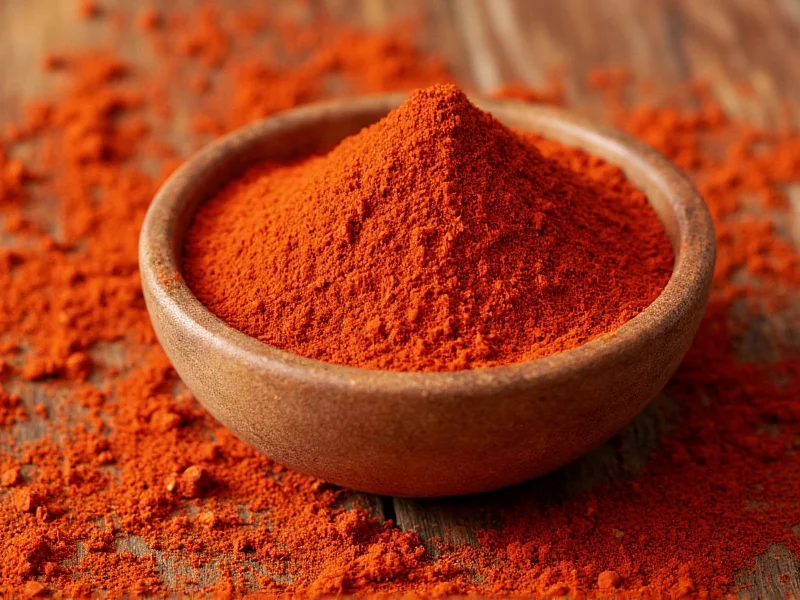Understanding the distinction between these two spice cabinet staples is essential for achieving authentic flavors in your cooking. While they may look similar in the jar, their production methods and resulting flavor profiles make them distinctly different ingredients that serve different culinary purposes.
What Exactly Is Paprika?
Paprika is a ground spice made from dried bell peppers and chili peppers. Originating in Central Mexico but popularized in Hungary, it's now produced worldwide with regional variations. The standard production process involves:
- Harvesting ripe peppers (typically Capsicum annuum varieties)
- Drying them in the sun or using mechanical dryers
- Removing stems and seeds
- Grinding the dried peppers into a fine powder
The flavor profile of regular paprika ranges from sweet and mild to slightly pungent, depending on the pepper varieties used. Hungarian paprika, considered the gold standard, comes in eight distinct varieties graded by heat and color intensity. Spanish paprika (pimentón) also offers sweet, bittersweet, and hot varieties, though without the smoking process that defines smoked paprika.
How Smoked Paprika Is Made Differently
Smoked paprika, known as pimentón de la Vera in Spain, undergoes a distinctive production method that creates its signature flavor. The key difference lies in the drying process:
- Peppers are dried slowly over oak wood fires for 10-15 days
- This traditional smoking method infuses the peppers with wood smoke
- The smoking occurs in special drying houses called secaderos
- After smoking, peppers are ground into powder like regular paprika
This centuries-old technique, protected by a Denomination of Origin in Spain's La Vera region, creates the deep, complex smokiness that defines this spice. The smoking process doesn't just add flavor—it transforms the chemical composition of the peppers, creating entirely different aromatic compounds compared to regular paprika.
Key Differences Between Paprika Varieties
| Characteristic | Regular Paprika | Smoked Paprika |
|---|---|---|
| Production Method | Sun-dried or air-dried peppers | Peppers smoked over oak fires for days |
| Flavor Profile | Sweet, mild pepper flavor | Distinct smoky, earthy notes with varying heat |
| Color | Bright red to deep orange | Rustic brick red to deep mahogany |
| Heat Level | Sweet (dulce), Bittersweet (agridulce), Hot (picante) | Available in sweet, medium, and hot smoked varieties |
| Primary Culinary Use | Color and mild pepper flavor in dishes | Adding smoky depth without actual smoking |
Culinary Applications: When to Use Each Type
Understanding regular paprika vs smoked paprika uses is crucial for recipe success. These spices aren't always interchangeable without affecting the final dish.
Regular paprika shines in:
- Classic Hungarian goulash and chicken paprikash
- Deviled eggs and potato salads
- Blending into spice rubs for mild flavor
- Adding vibrant color to soups and sauces
- Traditional Spanish rice dishes like paella (when specified)
Smoked paprika excels in:
- Spanish chorizo and other smoked sausages
- Bean dishes like fabada asturiana
- Adding smoky depth to vegetarian dishes
- Barbecue rubs and marinades
- Roasted vegetable preparations
- Enhancing tomato-based sauces with complexity
Substitution Guidance: Can You Swap Them?
Many home cooks wonder can I substitute smoked paprika for regular paprika (or vice versa). The answer depends on your recipe and desired outcome:
Substituting smoked for regular: Only do this when you want to add smoky notes. In Hungarian dishes, this substitution would create an inauthentic flavor. In bean dishes or barbecue recipes, smoked paprika often enhances the dish.
Substituting regular for smoked: This works when you need color and mild pepper flavor without smoke. In Spanish recipes specifically calling for smoked paprika, this substitution loses the essential smoky character.
For the closest approximation when substituting:
- Replace 1 tsp smoked paprika with 1 tsp regular paprika + 1/8 tsp liquid smoke (use sparingly)
- Replace 1 tsp regular paprika with mild smoked paprika at half the amount
Storage Recommendations for Maximum Freshness
Both paprika varieties lose potency faster than many spices due to their high oil content. To preserve their distinctive flavors:
- Store in airtight containers away from light and heat
- Keep in a cool, dark cupboard (not above the stove)
- Refrigeration extends shelf life significantly (up to 2 years)
- Check freshness by aroma—fresh paprika should have a vibrant scent
- Buy in small quantities from stores with high turnover
Common Misconceptions About Paprika Varieties
Several myths persist about these spices that can lead to cooking mistakes:
- Misconception: All paprika is the same regardless of origin
Reality: Hungarian, Spanish, and American paprikas have distinct flavor profiles - Misconception: Smoked paprika is always hot
Reality: It comes in sweet (dulce), medium (agridulce), and hot (picante) varieties - Misconception: The color indicates heat level
Reality: Deep red color relates to ripeness, not spiciness - Misconception: Paprika is just for color with no flavor
Reality: High-quality paprika provides essential flavor dimension
Final Thoughts on Paprika Selection
Understanding the difference between paprika and smoked paprika transforms your cooking from good to exceptional. While they may appear similar in the spice aisle, their distinct production methods create fundamentally different flavor experiences. Regular paprika provides authentic pepper flavor and vibrant color, while smoked paprika delivers that irreplaceable campfire essence without actual smoking.
When following recipes, pay close attention to which variety is specified—this detail often separates authentic preparations from approximations. Building a collection of both sweet paprika and smoked paprika (in sweet and hot varieties) gives you the versatility to create authentic dishes from Hungarian goulash to Spanish paella to American barbecue.
Remember that high-quality paprika makes a noticeable difference in your cooking. Seek out varieties with protected designations like Hungarian paprika or Spanish pimentón de la Vera for the most authentic flavors. Your dishes will thank you for understanding these paprika varieties and their culinary applications correctly.











 浙公网安备
33010002000092号
浙公网安备
33010002000092号 浙B2-20120091-4
浙B2-20120091-4